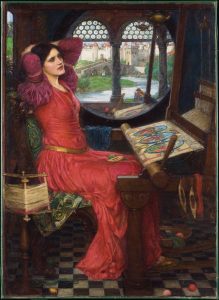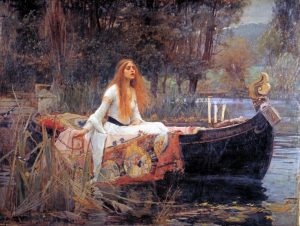4.3 True Love’s Broken Hearts
Hearts can be broken by unwanted harassment or worse. On the other hand, the purest of loving hearts can be broken by love’s outcome. This, too, is a story told and re-told through the ages.
Star-Crossed Tragedy
William Shakespeare. (1587). from Romeo and Juliet (1587). Prologue
(In fair Verona, where we lay our scene),
From ancient grudge break to new mutiny,
Where civil blood makes civil hands unclean.
From forth the fatal loins of these two foes
A pair of star-crossed lovers take their life;
Whose misadventured piteous overthrows
Doth with their death bury their parents’ strife.
Few phrases associated with love’s passion are as universally recognized as that of Shakespeare’s description of Romeo and Juliet: “a pair of star-crossed lovers.” The phrase is ambiguous. The stars ensure that the youths will love but also to come to grief. Love’s passion can lead to great exaltation, but also to heartbreak.
Act 5, Scene 3
ROMEO A grave? O, no. A lantern, slaughtered youth,
For here lies Juliet, and her beauty makes
This vault a feasting presence full of light.—
O my love, my wife,
Death, that hath sucked the honey of thy breath,
Hath had no power yet upon thy beauty.
Thou art not conquered. Beauty’s ensign yet
Is crimson in thy lips and in thy cheeks,
And death’s pale flag is not advancèd there. …
Ah, dear Juliet,
Why art thou yet so fair? …
Here, here will I remain
With worms that are thy chambermaids. O, here
Will I set up my everlasting rest
And shake the yoke of inauspicious stars
From this world-wearied flesh! Eyes, look your last.
Arms, take your last embrace. And, lips, O, you
The doors of breath, seal with a righteous kiss
A dateless bargain to engrossing death.
Kissing Juliet.
Come, bitter conduct, come, unsavory guide!
Thou desperate pilot, now at once run on
The dashing rocks thy seasick weary bark!
Here’s to my love. [Drinking] O true apothecary,
Thy drugs are quick. Thus with a kiss I die.
 |
| Auguste Couder. (1821). Romeo and Juliet. After Shakespeare. Oil on canvas |
JULIET What’s here? A cup closed in my true love’s hand?
Poison, I see, hath been his timeless end.—
O churl, drunk all, and left no friendly drop
To help me after! I will kiss thy lips.
Haply some poison yet doth hang on them,
To make me die with a restorative. [She kisses him.]
Thy lips are warm! …
Yea, noise? Then I’ll be brief. O, happy dagger,
This is thy sheath. There rust, and let me die.
She takes Romeo’s dagger, stabs herself, and dies.
We use the term Falling Action to refer to final, low-tension scenes in which story issues resolve themselves after the crisis of the plot’s climax. Romeo and Juliet concludes with grieving parents who end their feud and sad commentary from the prince:
The sun for sorrow will not show his head.
Go hence to have more talk of these sad things.
Some shall be pardoned, and some punishèd.
For never was a story of more woe
A Lady’s Heartbreak
Falling in love: what glorious hopes burst from that moment. And what heartbreak all too often follows. Songs of passions heartbreak are as common as celebrations of heartbreak’s glories.
Like many Victorian artists, Alfred, Lord Tennyson fused in his poetry ghosts of Britain’s past with the tastes and morals of the age. In a series of inventive neo-epics, he retold tales from the misty myths of King Arthur’s glory in the magical castle of Camelot. Like other 19th Century poets, Tennyson embraced the tradition of the Ballad, although transforming it into a highly literary form. Unlike Folk Ballads, which evolved reflecting the voices of countless bards, his Literary Ballads were composed in the distinctive style of a highly literate poet.
Tennyson’s “The Lady of Shallot” laments the sad, sterile life of a character in the Arthurian tales known as Elaine who suffered from her unrequited love for the dashing Sir Lancelot. Can you relate to the Lady’s sorrows? Have you known people who have shared them?
Alfred, Lord Tennyson. (1842). from The Lady of Shalott
from Part I
On either side the river lie
Long fields of barley and of rye,
That clothe the wold[1] and meet the sky;
And thro’ the field the road runs by
To many-tower’d Camelot.[2] …
Only reapers, reaping early
In among the bearded barley,
Hear a song that echoes cheerly
From the river winding clearly,
Down to tower’d Camelot:
And by the moon the reaper weary,
Piling sheaves in uplands airy,
Listening, whispers “ ‘Tis the fairy
Lady of Shalott.”
from Part II
There she weaves by night and day
A magic web with colors gay.
She has heard a whisper say,
A curse is on her if she stay
To look down to Camelot.
She knows not what the curse may be,
And so she weaveth steadily,
And little other care hath she,
The Lady of Shalott.
And moving thro’ a mirror clear
That hangs before her all the year,
Shadows of the world appear.
There she sees the highway near
Winding down to Camelot. …
But in her web she still delights
To weave the mirror’s magic sights,
For often thro’ the silent nights
A funeral, with plumes and lights
And music, went to Camelot:
Or when the moon was overhead,
Came two young lovers lately wed:
“I am half sick of shadows,” said
The Lady of Shalott.
[1] Wold: an area of high ground without trees
[2] Camelot: the mythical palace and fortress from which Arthur, King of the Celtic Britons, led his noble knights in their quests.
 |
| John Waterhouse. (1915). “I am half sick of shadows,’ said The Lady of Shalott. Oil on canvas. |
So. What story is Tennyson weaving? An English countryside near the castle of Camelot. And a voice singing a song, the song of the isolated Lady of Shalott. Elaine sits at her window and watches the world go by. She sees the handsome knight Lancelot passing by her window and begins to weave a dream of love’s sweet joy. Her steadfast weaving is troubled by whispers of a curse settling upon her. Well, what do you think? How does a curse arise from her life of an open window and woven fantasy?
Gradually, Elaine’s fantasy slides from joyful anticipation to unrequited grief. She begins to find it difficult to content herself with shadowy figures: people outside living life and the magical webs she weaves on her loom and in her mirror. And she finds herself “half sick of shadows.”
Mired in despair, Lady Elaine realizes that the promised curse—you will be lost if you remain alone, gazing on Camelot and fantasizing about Lancelot. Her morbid half-life slips away and she finds a kind of peace in a drifting boat.
from Part III
She left the web, she left the loom,
She made three paces thro’ the room,
She saw the water-lily bloom,
She saw the helmet and the plume,
She look’d down to Camelot.
Out flew the web and floated wide;
The mirror crack’d from side to side;
“The curse is come upon me,” cried
The Lady of Shalott.
from Part IV
Down she came and found a boat
Beneath a willow left afloat,
And round about the prow she wrote
The Lady of Shalott. …
And at the closing of the day
She loosed the chain, and down she lay;
The broad stream bore her far away,
The Lady of Shalott. …
And as the boat-head wound along
The willowy hills and fields among,
They heard her singing her last song,
The Lady of Shalott. …
For ere she reach’d upon the tide
The first house by the water-side,
Singing in her song she died,
The Lady of Shalott. …
Who is this? and what is here?
And in the lighted palace near
Died the sound of royal cheer;
And they cross’d themselves for fear,
All the knights at Camelot:
But Lancelot mused a little space;
He said, “She has a lovely face;
God in his mercy lend her grace”
The Lady of Shalott.”
 |
| John Waterhouse. (1888). The Lady of Shalott. Oil on canvas. |
Irony of ironies. How does the Falling action of the ballad provide a bittter coda to Elaine’s story? When does Lancelot finally notice Elaine’s beauty? How do you read Elaine’s tale? Is she passion’s victim or a sad soul addicted to a self-destructive obsession?
We should keep in mind that aristocratic women in the feudal past and in Tennyson’s day had few options besides marriage. Authoritarian Lords decided whether and whom their daughters would marry; young ladies’ affections and passions meant little to anyone involved. Those who resisted or who were simply left behind due to lack of interest lived shadow lives of dependency on families which little regarded them.
But of course, people from any social sphere can suffer heartbreak. And the temptation to despairing isolation is always there. Has anyone in your life found themselves “half sick of shadows”?
References
Couder, Auguste. (1821). Romeo and Juliet [Painting]. Angers, FR: Musée des beaux-arts. AN ART149536. https://ow-mba.angers.fr/fr/notice/1996-37-1-scene-de-romeo-et-juliette-de-shakespeare-une-97ccbeec-b479-40f7-83b3-65e1197d7669
Shakespeare, W. (1597). Romeo and Juliet. (B. Mowat, P. Werstine, M. Poston, and R. Niles, eds.). The Folger Shakespeare. https://www.folger.edu/explore/shakespeares-works/romeo-and-juliet/read/
Tennyson, A. (1842). The Lady of Shallot. Poems. Poetry Foundation https://www.poetryfoundation.org/poems/45360/the-lady-of-shalott-1842
Waterhouse, J. (1915). “I am half sick of shadows,’ said The Lady of Shalott [Painting]. Toronto, Ontario: Art Gallery of Ontario. https://ago.ca/collection/object/71/18
Waterhouse, J. (1888). The Lady of Shalott [Painting]. London, UK: The Tate Gallery. https://www.tate.org.uk/art/artworks/waterhouse-the-lady-of-shalott-n01543
(or Dénouement) in narrative, the low-tension scenes in which story issues resolve themselves after the crisis of the plot’s climax
a poem or song that tells a story. Traditionally, oral poetic genres compiled anonymously within folklore traditions for audiences with limited literary education
a traditional story in song or verse composed, adapted, and performed over a long time by bards and their audiences. Folk ballads reflect the life of common people, often marked by themes of grief and loss.
a hybrid form which, like traditional ballads, tells in verse while reflecting the styles and conventions of the literary tradition as well as the voice of the author. Literary ballads were generally not composed to be sung to music.
an often wryly humorous, indirect mode of communication that asks the reader to compare what is said with some known or signified reference. Frequently used to puncture false pretentions, especially of the social elite. E.g. a standup comedian who relies on the audience to draw on what it knows about a celebrity to get the joke.
